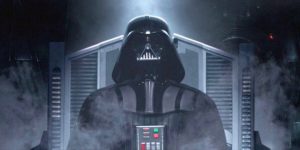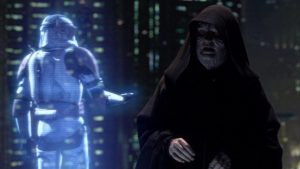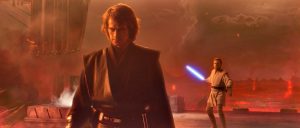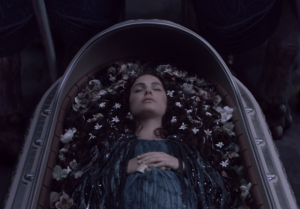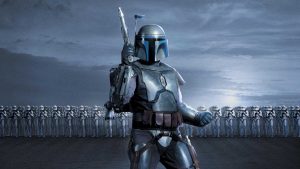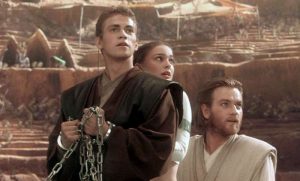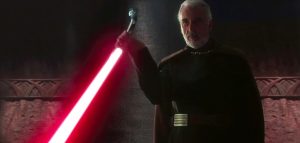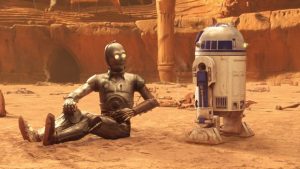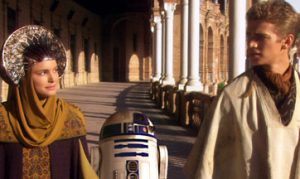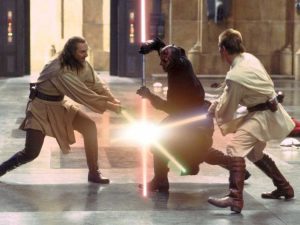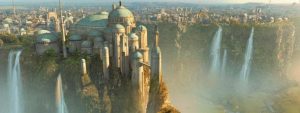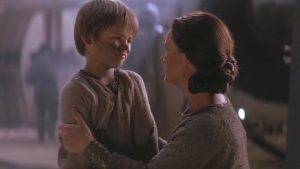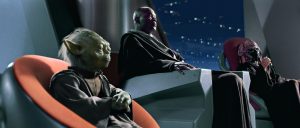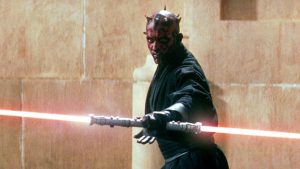The Skywalker Saga has concluded in fire, blood and Force lightning. After forty-two years of incredible journeys across the stars, from Naboo to Mustafar to Tatooine and Endor, from clone wars and intergalactic trade disputes to hopeless rebellions, empires, and the like, we have finally reached the story’s final, and defining, chapter. And that means it’s time to discuss all the major reveals, revelations and shocking surprises in a movie that is largely made up of such moments, in my spoiler review of Star Wars: The Rise Of Skywalker.
And, um, SPOILERS AHEAD, obviously.

There is a lot to love in this film, and a lot of elements and plot-points that have already been generating arguments and heated debates throughout the Star Wars fandom. We’re going to go through each of the film’s most divisive surprises, from low-stakes squabbles to the-fate-of-the-universe-hangs-in-the-balance battles.
Let’s start the ball rolling with two moments that absolutely could have been high-stakes scenes, but were quickly undermined. The first involved everybody’s favorite Wookie, Chewbacca (Joonas Suotamo), and his fakeout death on the desert planet of Pasaana. Chewie is captured by stormtroopers and almost gets carried away in a transport shuttle, before Rey (Daisy Ridley) and Kylo Ren (Adam Driver) use the Force to drag the ship this way and that in a potentially fatal game of tug-and-war. This moment echoes an iconic The Last Jedi scene in which Rey and Kylo struggle for mastery over Luke Skywalker’s old lightsaber, but here the outcome is that Rey suddenly unleashes a fiery explosion of Force lightning to try and overcome Kylo’s grip, blowing up the shuttle and giving us a hint of her Sith heritage. Fortunately for Rey, Chewie wasn’t killed in the explosion after all, and survives all the ensuing violence to finally get rewarded with his very own medal, having waited forty-two years to get recognition for his help in destroying the Death Star. Later in the movie, the same sort of scenario involves C-3PO (Anthony Daniels), who has to have his memory completely wiped so that he can be made to speak Sith, so that Rey can find the ruins of the Death Star, so that she can discover a Sith Wayfinder which Kylo ultimately destroys in the palm of his hand, so…there was no reason for C-3PO to have his memory wiped at all. Thankfully the movie remembers this and has an irate R2-D2 (Hassan Taj/Lee Towersey) reverse the override and restore C-3PO’s fond recollections of his best friend. The moment when he “dies” is still emotional, and does lead to some funny jokes, as all good C-3PO scenes do, but all of those theories about “Sith-3PO” were making mountains out of one very small, unimportant molehill.
The relationship dynamics in Rise Of Skywalker are next on the list, not only because of how screentime is wasted on them, but because of how unbearably messy they are. It’s no secret anymore that director J.J. Abrams and The Last Jedi director Rian Johnson couldn’t ever figure out any sort of continuity between their films, but the whiplash of seeing our protagonists leap at light-speed from one relationship to the next here seems to imply that Abrams can’t even establish continuity with…himself. Rey and her possibly Force-sensitive friend Finn (John Boyega) were the sequel trilogy’s “original” love story, back when Finn was cool for about five minutes, but that was before the fandom collectively went crazy for “Reylo”, the popular coupling of Rey and Kylo Ren that finally gets payoff in Rise Of Skywalker with the pair’s first kiss and declarations of mutual love – sort of: Driver and Ridley speak volumes with subtle gestures, and don’t really need to say anything at all. Such is not the case for Finn, who spends a large part of the movie waiting to tell Rey something, presumably something romantic, before just…forgetting? Moving on? He clearly has some emotions for her at the beginning of the film, despite having been caught up in a romantic entanglement with fellow Resistance fighter Rose Tico (Kelly Marie Tran) in The Last Jedi, and with fellow ex-stormtrooper Jannah (Naomi Ackie) here in Skywalker. But then again, Poe Dameron (Oscar Isaac) also maybe has a thing for Rey, or was I the only one getting that from their weirdly flirtatious exasperated argument in the film’s opening scenes, which even features droid BB-8 humorously looking back and forth between the two characters as Rey reprimands Poe for lightspeed-skipping in the Millennium Falcon, and Poe tells her off for damaging BB-8 (even as relationships crash and burn around them, Poe and BB-8 are resolutely loyal to each other: there’s a love story for you, and it would still be less weird than whatever was going on between Lando Calrissian (Billy Dee Williams) and the much-younger Jannah during the film’s finale). Meanwhile the film continues to tease the idea of semi-romantic tension between Finn and Poe in the subtlest possible way, while also giving Poe a former female love interest of his own, one who doesn’t really have a whole lot to do except be Poe’s former female love interest. I think the crucial element here is that she’s female: after all, gotta squash all those gay rumors. Having a two-second lesbian kiss is surely enough to make up for no substantial LGBTQ+ representation in forty-two years (and for certain countries, it was apparently too much).
Let’s move on to female characters, who, with the obvious exceptions of Rey and Princess Leia (Carrie Fisher, in her final, posthumous appearance), tend to get the bare minimum of screen-time or development. I’d be hard pressed to tell you what I thought of Jannah, Rose Tico or Zorii Bliss (Keri Russell), none of whom actually has anything to do except look cool, stand around, or stand around and look cool. Both Jannah and Zorii are at least technically supposed to have a handful of emotional beats each, but Rose especially seems to exist solely to make sure angry audience-members don’t ask where she went. But she might as well just not be here at all – she has maybe two or three throwaway lines, few if any character-building moments, and seemingly no acknowledgement of the fact that she was Finn’s love interest in the previous movie. I didn’t even think they were a particularly cute couple, but after the nightmare that actress Kelly Marie Tran went through, experiencing bullying and harassment from toxic fans, it seems suspiciously convenient that she’s little more than an extra in this film.
Other characters who fail to make an impression (and don’t worry, we’re almost done with the film’s big negatives), even after being hyped-up in the marketing, include Dominic Monaghan as another extra whose name I have already forgotten; Lupita Nyong’o reprising her role as Maz Kanata (another female character pretty much wasted); the super-creepy alien assassin Ochi of Bestoon (Liam Cook), who killed Rey’s parents and was then devoured by a giant sand-worm; and, unfortunately, Rey’s actual parents, played by Billy Howle and Jodie Comer. Yes, the very same Jodie Comer who is one of the Hollywood’s biggest rising stars at the moment – how are we not talking about the fact that she is in Star Wars, people?

J.J. Abrams was always going to have to struggle to come up with an explanation for how Rey’s parents could technically be nobodies, but also somebodies: what he devised is pretty complex, so stick with me here. Rey’s grandfather is Emperor Palpatine (Ian McDiarmid), and her father is Palpatine’s hitherto-unknown son. Before this extraordinary reveal, it was never indicated that Palpatine ever had a son, or a family, or a life, for that matter: not as the Emperor, not even as Sheev Palpatine, Senator from Naboo. Not only are we never told the son’s name, or when he was born, where he came from, or whether he was Force-sensitive himself, but we are never given the answer to the most glaringly obvious question that arises as a result of this reveal: who, dare I ask, was the poor unfortunate soul that birthed Palpatine’s son, and…um, why? Was he born when Palpatine was still a relatively human person, or after Palps had transformed into the ghastly, shriveled-up hobgoblin that we’re most familiar with? Anyway, Rey’s Father, it is revealed, chose to be a nobody instead of embracing his family name, and that’s why he and his wife sold their daughter into a torturous life of basically slavery, to protect her from Palpatine – because of course any good parent, knowing they’re about to die, would choose to sell their own child to an abusive community of junk-traders and scavengers rather than, oh I don’t know, leaving her with people who might actually care about her safety! And of course it makes sense that, after killing the parents, Ochi of Bestoon didn’t fly back to Jakku and hunt down the only human girl in a village that we saw in The Force Awakens was probably less than a mile wide. In other words, while the parents were marginally necessary, it would’ve probably made more sense to have her be, like Anakin, the result of Palpatine’s meddling with midi-chlorians (or are we still trying to ignore those were ever a thing?). She could still have been a Palpatine, and we wouldn’t be left with the horrifying implied revelation that Palpatine actually fathered a child.
Apart from the messiness of the Rey Palpatine reveal, the Emperor’s return is a welcome one. His resurrection is completely unexplained (“The dead speak!”, the film’s opening crawl reads, and that’s about as much explanation as you’re gonna get), but it’s nice to see that he isn’t totally back in shape after being tossed into the hellfire that was the second Death Star’s utter obliteration: now, the Emperor’s limp, skeletal body moves around on the end of a long metal crane-arm extended from the ceiling of his throne room on the Sith planet Exegol, like a creepy ventriloquist doll speaking with the voices of a thousand generations of Jedi. McDiarmid is obviously fabulous, and even gets to briefly return to a form we last saw him take in Revenge Of The Sith, as he sucks the life force out of Rey and Kylo Ren to repair his broken body and restore his strength. This time around he’s extra moody, having just discovered that his granddaughter doesn’t want to take part in the Palpatine family photo-op with his millions of ghostly Sith followers. And so, with no choice left to him but to destroy the universe, he unleashes the Final Order.

The Final Order is appropriately ominous at first, as we see hundreds of titanic star destroyers rise from beneath the ice of Exegol, each armed with a planet-destroying weapon, to wreak havoc on the galaxy and establish Palpatine’s dominion. But these weapons are only used, to obliterate a single planet, and as a result the Final Order is ultimately defeated by a cavalry of space-goats. For the record, I have no complaints about that – in Star Wars, the underdog always comes out on top, and we love to see it. The film’s epic finale has Lando Calrissian and about a billion other spaceships pop out of hyperspace to come rescue the goat-riders and put an end to General Pryde (Richard E. Grant) and his menacing fleet – though not before a couple more deaths, including that of pilot Snap Wexley (Greg Grunberg), who gets shot down just before the battle turns in the Resistance’s favor. Bad timing, Snap.

But few of the film’s scenes hit home quite like Leia Organa’s death, and the extensive use of ghosts, Force-ghosts and Jedi voice-overs. Midway through the movie, as Kylo Ren and Rey duel to the death amongst the shattered ruins of the Death Star, Leia finally reaches out to her son through the Force, using all of her Jedi training to find her son, the Ben Solo she knew and still loved, and bring him back to the Light Side. She succeeds, but has to use all of her remaining strength to achieve victory over the corrupting influence of Palpatine and his puppet Snoke (voiced by Andy Serkis), who had stolen Ben away from her and turned him into Kylo Ren. In the end, though Leia passes away in the attempt, she is a crucial element in the Skywalker Family’s victory over the Sith, just as we had all hoped she would be. There is no doubt that, if Carrie Fisher were still alive, then Leia would have had a much larger role in this film, but what we get is still powerful and emotionally satisfying – Luke Skywalker’s Force-ghost tells Rey that Leia actually trained to be a Jedi after the fall of the Empire, and he even gives her Leia’s very own lightsaber, which Rey subsequently uses, along with Luke’s a.k.a Anakin’s, to defeat Palpatine, symbolically uniting the power of all the previous Skywalkers against the Emperor. But it’s not just the Skywalkers who stand with Rey – it’s all of the past Jedi, who visit Rey as voices in her head as she lies, almost lifeless, on the ground at Palpatine’s feet: and I’m not even just talking Luke Skywalker (Mark Hamill) and Yoda (Frank Oz). A whole bunch of fallen Jedi give advice and courage to our protagonist in that moment, from Obi-Wan Kenobi (voiced by Ewan McGregor and Alec Guinness) Qui-Gon Jinn (voiced by Liam Neeson) and Mace Windu (voiced by Samuel L. Jackson), to some of the extended universe’s most notable heroes like Kanan Jarrus (Freddie Prinze Jr.) and Ahsoka Tano (voiced by Ashley Eckstein), who apparently died a Jedi despite (a) being alive the last time we saw her, and (b) leaving the Jedi Order in The Clone Wars. Fittingly, the final word is given to Anakin Skywalker (Hayden Christensen) himself, as the Jedi-turned-Sith-turned-Jedi tells Rey to restore balance to the Force and finish what he started. But even as a thousand generations of Jedi live inside Rey (something she acknowledges in an Iron Man-esque growl of determination, with her “I am all the Jedi” line), so too does Ben Solo have his own ghosts. Soon after being redeemed by his mother’s purifying love, Ben has a conversation with the ghost of his father, Han Solo (Harrison Ford), who actually appears physically – and, weirdly, also has audible footsteps, despite being intangible – and, in typical Han fashion, abruptly cuts his son off before he can start apologizing for all his sins with a quick “I know”, echoing his long-ago declaration of love to Princess Leia.
There are many echoes reverberating in The Rise Of Skywalker, from quick but powerful payoffs, to a number of startlingly poetic parallels. Even Luke Skywalker is still developing as a character even after his death, finally managing to lift his X-Wing fighter jet from the waters of Ahch-To even after infamously failing to do so on Dagobah in The Empire Strikes Back. Ben Solo echoes Anakin’s redemption arc by turning to the Light at the end of the movie, helping Rey to defeat Palpatine. And it’s Palpatine’s own Force-lightning which Rey deflects back into his hideous face, ultimately disintegrating the Emperor (in what appears to be a Raiders Of The Lost Ark callback) and preventing Rey herself from succumbing to the Dark Side. And then, she sort of dies.
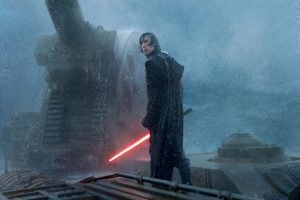
But thankfully, all those Force-phone calls between Rey and Ben were actually leading up to something, and something big: while in The Last Jedi they mostly just provided the two characters a way to communicate, Rise Of Skywalker adds a new wrinkle to the relationship, allowing Rey and Ben the ability to transfer physical objects via telepathy, including a beaded necklace, Darth Vader’s helmet, and a helpful lightsaber. Ben, cradling Rey’s dead body in his arms after the battle, is able to take things one step further by physically transferring his own life to Rey, reviving her but also killing himself in the process. Rey is quick on the uptake and manages to steal a kiss from the redeemed Jedi, just before he fades away into the Force, leaving Rey Palpatine to carry on with the massive burden placed upon her by generations of Jedi, Sith and Force meddling.
One thing she will not be carrying anymore is the Palpatine family name, which she abandons in the film’s final scene in exchange for “Skywalker”. The scene is a poignant one: Rey goes to Tatooine and buries Luke and Leia’s twin lightsabers just outside the Lars moisture-farm where the story began back in 1977. The Skywalker siblings’ Force-ghosts, united in death, look on as she takes up their family name and sets out into the double sunset with BB-8 beside her, and a lightsaber of her own (a lightsaber that I and many others think is yellow, while others claim it’s white). This is undoubtedly the film’s most controversial move: on the one hand, it makes sense that Rey wouldn’t want to be a Palpatine, and it’s poetic for her to adopt the Skywalker name, making sure that their name never dies out from the galaxy. On the other hand, fans are upset that Rey didn’t simply choose to keep the Palpatine name and redefine her grandfather’s legacy, proving that you can still be a good person, no matter where you come from or who your family happens to be. Both arguments are understandable, but at the end of the day it comes down to the fact that Star Wars has always been the story of the Skywalker family – to let their memory die out, buried in the sands of Tatooine, would be a dishonor to their legacy.

And with that, the story of Skywalker is finished, once and for all. Peace has been restored to the galaxy. Balance in the Force has been achieved, through the actions of Rey Skywalker and Ben Solo, champions of the Light and Dark, who came together in what they called a “Force dyad” to become the “two that are one” – remember my Star Wars recap reviews, where I told you that duality would have a part to play in this last movie? I didn’t even expect that sort of shoutout in the film’s own dialogue (I expected it to be all in the subtext), but the confirmation was highly appreciated. The Empire, The First Order, and The Final Order have all been vanquished, and nobody needs to build any more Death Stars. For the first time, the galaxy is completely tranquil, and we no longer need to worry about what Sith Lord will rise next, because there won’t be another Sith Lord. This is it. This is the end.
We, the fans of this incredible franchise, have finally brought the story home. There will undoubtedly be much more Star Wars to come in future years, whether in the form of prequels or sequels, but I hope that Disney never feels the need to resurrect Palpatine once again, or bring the Skywalkers back. Any tampering along those lines would serve only to ruin the perfection of this pure, beautiful moment.
This is the ending we’ve been looking for.
